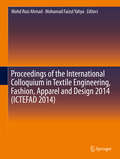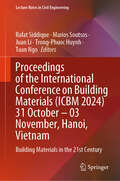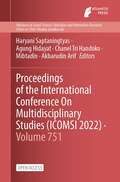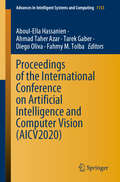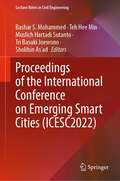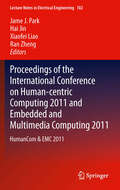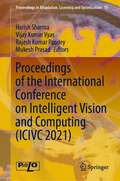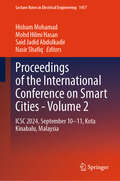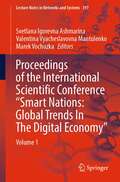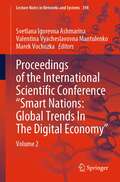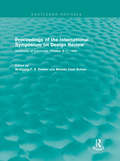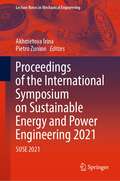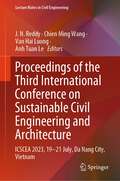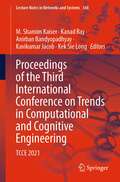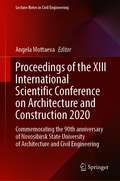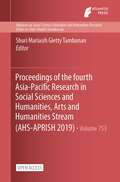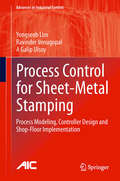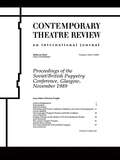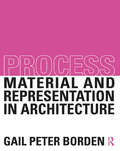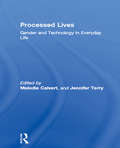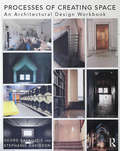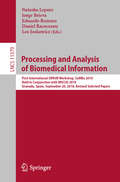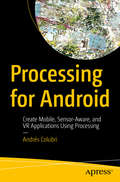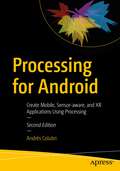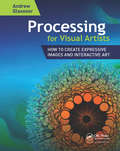- Table View
- List View
Proceedings of the International Colloquium in Textile Engineering, Fashion, Apparel and Design 2014 (ICTEFAD #2014)
by Mohd Rozi Ahmad Mohamad Faizul YahyaThe book is a collection of academic papers from a conference that focuses on significant issues, fundamental and applied research advances on a range of topics in the areas of textile engineering, apparel, fashion and design. Among others, the book will update the readers on recent research in technical and functional textiles; future trends and visions for textile, apparel and fashion; global business, marketing and management in textile and apparel; education and training in textile and apparel and design, fashion, footwear product and materials innovation.
Proceedings of the International Conference on Building Materials: Building Materials in the 21st Century (Lecture Notes in Civil Engineering #585)
by Juan Li Rafat Siddique Marios Soutsos Trong-Phuoc Huynh Tuan NgoThis volume presents articles from the International Conference on Building Materials; ICBM2024 with the theme “Building Materials in the 21st Century”, held at Hanoi in Vietnam, from 31st October to 03rd November. The conference is a diversified-topic forum for international and Vietnamese researchers, academics, industry professionals, experts and policy makers etc. to share their views, and to learn from others about recent and current developments in science and technology of building materials in the 21st century and also to discuss actions required for forthcoming building materials as well as construction development in the future. The book highlights recent research on cement, concrete, refractory materials, fire-resistant materials, paints, glass, product quality testing methods, environmental protection and recycling wastes in building material industry.
Proceedings of the International Conference On Multidisciplinary Studies (Advances in Social Science, Education and Humanities Research #751)
by Haryani Saptaningtyas Agung Hidayat Chanel Tri Handoko Mibtadin Akbarudin ArifThis is an open access book. 1st International Conference on Multidisciplinary Studies (ICoMSi) offers a track of quality R&D from key researchers and experts. It provides an opportunity in bringing in the new hope and horizons that will contribute to Advanced research and policy on Culture, Environment, Health, and Community Development after pandemic. All submitted papers will be under peer review and accepted papers will be published in the conference proceeding. Both academia, activists and industries are invited to present their papers dealing with state-of-art research, sustainable developments, and goods practices of community development after pandemic.
Proceedings of the International Conference on Artificial Intelligence and Computer Vision (Advances in Intelligent Systems and Computing #1153)
by Aboul-Ella Hassanien Ahmad Taher Azar Tarek Gaber Diego Oliva Fahmy M. TolbaThis book presents the proceedings of the 1st International Conference on Artificial Intelligence and Computer Visions (AICV 2020), which took place in Cairo, Egypt, from April 8 to 10, 2020. This international conference, which highlighted essential research and developments in the fields of artificial intelligence and computer visions, was organized by the Scientific Research Group in Egypt (SRGE). The book is divided into sections, covering the following topics: swarm-based optimization mining and data analysis, deep learning and applications, machine learning and applications, image processing and computer vision, intelligent systems and applications, and intelligent networks.
Proceedings of the International Conference on Emerging Smart Cities (Lecture Notes in Civil Engineering #324)
by Bashar S. Mohammed Teh Hee Min Muslich Hartadi Sutanto Tri Basuki Joewono Sholihin As’adThis book contains papers presented at the International Conference on Emerging Smart Cities (ICESC2022), previously known as the International Conference on Civil, Offshore and Environmental Engineering (ICCOEE). ICESC is held under the banner of World Engineering, Science and Technology Congress (ESTCON2022) from 1 to2 December 2022 at Borneo Convention Centre, Kuching, Sarawak, Malaysia. This proceeding contains papers presented by academics and industrial practitioners showcasing the latest advancements and findings in civil engineering areas with an emphasis on emerging smart cities for the ultimate shape of urban living in the near future. The papers are categorized under the following tracks: (1) Climate Adaptive materials; (2) Environmental sustainability; (3) Infrastructure efficiency.
Proceedings of the International Conference on Human-centric Computing 2011 and Embedded and Multimedia Computing 2011
by Hai Jin Xiaofei Liao James J. Park Ran ZhengProceedings of the International Conference on Human-centric Computing and Embedded and Multimedia Computing (HumanCom & EMC 2011) will cover topics of HumanCom and EMC, the current hot topics satisfying the world-wide ever-changing needs. Human-centric computing is to create novel solutions so that the humans are always connected, portable, and available. As with pervasive-computing, human-centric computing requires a variety of devices; however, such devices exist simply to obtain inputs from the human and are embedded in objects that humans interact with on a daily basis. Moreover, during the past couple of decades, Information Science technologies influenced and changed every aspect of our lives and our cultures. Without various Information Science technology-based applications, it would be difficult to keep information stored securely, to process information efficiently, and to communicate conveniently. Embedded computing ranges from portable devices such as digital watches and MP3 players, to large stationary installations like traffic lights, factory controllers, or the systems controlling nuclear power plants. Complexity varies from low, with a single microcontroller chip, to very high with multiple units, peripherals and networks mounted inside a large chassis or enclosure. Multimedia computing covers multimedia I/O devices, OS, storage systems, streaming media middleware, continuous media representations, media coding, media processing, etc., and also includes multimedia communications; real-time protocols, end-to-end streaming media, resource allocation, multicast protocols, and multimedia applications; databases, distributed collaboration, video conferencing, 3D virtual environments.
Proceedings of the International Conference on Intelligent Vision and Computing (Proceedings in Adaptation, Learning and Optimization #15)
by Harish Sharma Mukesh Prasad Vijay Kumar Vyas Rajesh Kumar PandeyThis book gathers outstanding research papers presented at the International Conference on Intelligent Vision and Computing (ICIVC 2021), held online during October 03–04, 2021. ICIVC 2021 is organised by Sur University, Oman. The book presents novel contributions in intelligent vision and computing and serves as reference material for beginners and advanced research. The topics covered are intelligent systems, intelligent data analytics and computing, intelligent vision and applications collective intelligence, soft computing, optimization, cloud computing, machine learning, intelligent software, robotics, data science, data security, big data analytics, and signal natural language processing.
Proceedings of the International Conference on Smart Cities - Volume 2: ICSC 2024, September 10-11, Kota Kinabalu, Malaysia (Lecture Notes in Electrical Engineering #1417)
by Nasir Shafiq Hisham Mohamad Mohd Hilmi Hasan Said Jadid AbdulkadirThis book contains papers presented at the International Conference on Smart Cities (ICSC 2024) under the banner of World Engineering, Science & Technology Congress (ESTCON 2024) held from September 10 to 11, at Sabah International Convention Centre, Kota Kinabalu, Malaysia. The conference contains papers presented by academics and industrial practitioners showcasing their latest advancements and findings in emerging smart cities and sustainable urban living. The papers are categorized under the following tracks and topics of research: (1) Sustainable Engineering for Building; (2) Blockchain and Cybersecurity; (3) Artificial Intelligence (AI); (4) Smart Transportation System; and (5) Low-Carbon Planning for Sustainable City.
Proceedings of the International Scientific Conference “Smart Nations: Volume 1 (Lecture Notes in Networks and Systems #397)
by Marek Vochozka Svetlana Igorevna Ashmarina Valentina Vyacheslavovna MantulenkoThis book contains contributions from an international scientific conference, “Smart Nations: Global Trends In The Digital Economy”, which was organized by the State University of Management (Moscow). By presenting international research on the issues of the Smart Nations concept, this book includes topics such as state and legal aspects of digital transformation of management systems, new technologies in the digital environment of the information society and smart economy as a new reality. The conference proceedings cover legal, informational, technological and other aspects of socio-economic development in the context of digital innovations. This work addresses theoretical and practical aspects by studying the phenomenon of Smart Nations that requires understanding the modern information technologies, big data analysis, distributed registry management, new microprocessor technologies and broadband data transmission technologies in terms of their usefulness and accessibility to any representative of humanity.
Proceedings of the International Scientific Conference “Smart Nations: Volume 2 (Lecture Notes in Networks and Systems #398)
by Marek Vochozka Svetlana Igorevna Ashmarina Valentina Vyacheslavovna MantulenkoThis book contains contributions from an international scientific conference, “Smart Nations: Global Trends In The Digital Economy”, which was organized by the State University of Management (Moscow). By presenting international research on the issues of the Smart Nations concept, this book includes topics such as smart business in a "smart city", digital marketing systems and Smart Nations phenomenon: social and business aspects. The conference proceedings cover legal, informational, technological and other aspects of socio-economic development in the context of digital innovations. This work provides significant value for scientists, teachers and students of higher educational institutions and specialists, who are researching socio-economic development issues in the era of smart technologies.
Proceedings of the International Symposium on Design Review: University of Cincinnati, October 8-11, 1992 (Routledge Revivals)
by Wolfgang F.E. Preiser Brenda Case ScheerFirst published in 1992, this book collects together the papers presented at the International Symposium on Design Review which was held to address the growing tendency of local governments to institute programs of aesthetic control. The editor argues that the widespread adoption of design review processes in the years preceding the conference necessitated thoroughgoing professional criticism and a number of areas of debate are identified and addressed in the subsequent papers. Are the difficulties experienced by planners, community activists and architects with the process due to its relative youth or inherent flaws in the entire concept? How should mechanical problems like time and expense, the ease with which the process can be manipulated, and general inefficiencies in the system be resolved? More intricate problems are also addressed, such as: who has the power to judge the aesthetic quality of a building, whether design review infringes on the rights of the individual especially under the First Amendment, whether the design review process is "fair", and the difficulty for the reviewer of deciding what is right and what is wrong having taken into account factors that can be highly subjective or contradict more practical concerns.
Proceedings of the International Symposium on Sustainable Energy and Power Engineering 2021: SUSE 2021 (Lecture Notes in Mechanical Engineering)
by Akhmetova Irina Pietro ZuninoThis book comprises the proceedings of the International Symposium on Sustainable Energy and Power Engineering (SUSE) 2021. The contents of this volume focus on recent technological advances in the field of energy efficiency and green buildings, new construction materials and related technology, hydrogen and renewable energy, environmental aspects of the modern power industry, etc. The contents cover latest advances especially in digital transformation of society and economy of the energy sector, turbomachines and combined plants, intelligent energy systems. This volume will prove a valuable resource for those in academia and industry.
Proceedings of the Third International Conference on Sustainable Civil Engineering and Architecture: ICSCEA 2023, 19–21 July, Da Nang City, Vietnam (Lecture Notes in Civil Engineering #442)
by J. N. Reddy Chien Ming Wang Van Hai Luong Anh Tuan LeThis book includes articles from the Third International Conference on Sustainable Civil Engineering and Architecture (ICSSEA 2023), held at Da Nang City, Vietnam, on July 19-21, 2023. The conference brings together international experts from both academia and industry to share their knowledge and expertise, facilitate collaboration, and improve cooperation in the field. The book focuses on the most recent developments in sustainable architecture and civil engineering, including offshore structures, structural engineering, building materials, and architecture.
Proceedings of the Third International Conference on Trends in Computational and Cognitive Engineering: TCCE 2021 (Lecture Notes in Networks and Systems #348)
by Kanad Ray Anirban Bandyopadhyay M. Shamim Kaiser Kavikumar Jacob Kek Sie LongThis book presents various computational and cognitive modeling approaches in the areas of health, education, finance, environment, engineering, commerce, and industry. It is a collection of selected conference papers presented at the 3rd International Conference on Trends in Cognitive Computation Engineering (TCCE 2021), hosted online by Universiti Tun Hussein Onn Malaysia (UTHM) during October 21–22, 2021. It shares cutting-edge insights and ideas from mathematicians, engineers, scientists, and researchers and discusses fresh perspectives on problem solving in a range of research areas.
Proceedings of the XIII International Scientific Conference on Architecture and Construction 2020: Commemorating the 90th anniversary of Novosibirsk State University of Architecture and Civil Engineering (Lecture Notes in Civil Engineering #130)
by Angela MottaevaThe book contains the latest studies on digitalization of transport and logistics, improving vehicle fuel efficiency, information technology and digital security, land management and cadastres, building structures, structural analysis, and energy conservation in construction. This book consists of papers presented during the XIII International Scientific Conference on Architecture and Construction 2020, which is dedicated to the 90th anniversary of Novosibirsk State University of Architecture and Civil Engineering, held on September 22–24, 2020. The book caters to researchers, scientists and industrial practitioners in the field of transportation engineering, logistics, intelligent transport systems, sustainable construction for housing and industrial buildings.
Proceedings of the fourth Asia-Pacific Research in Social Sciences and Humanities, Arts and Humanities Stream (Advances in Social Science, Education and Humanities Research #753)
by Shuri Mariasih Gietty TambunanThis is an open access book.According to Castells, power now rests in networks: “the logic of the network is more powerful than the powers of the network” (quoted in Weber, 2002, p. 104) – it is whether nation states or local communities are deeply affected, especially by inclusion in and exclusion from the global networks that structure a various sectors in society at any level. Thus it is also crucial look closely at exclusion from and inclusion in different kinds of social structures where connectivity and access to networks are essential, being aware that people at the bottom are those who, with nothing to offer the network, are excluded. Castells’ arguments shows us how the new forms of network society offer challenges in a way that despite the disappearance of conventional ties, exploitation, marginalization, exclusion and differentiation remain.In what follows, scholarships are invited to build an academic discussion on characterizing the structure and dynamics of societies in the world of the twenty-first century. Thus, scholar may come to look at the meaning of being in a network society by examining the role of network society within the complexity of socio-cultural, political and economic circumstances in strengthening the role of science in overcoming local, national, regional and global problems. But scientific research is also required to identify a wide variety of solutions to societal problems enhanced by the network society, which no longer relate solely to a particular discipline, but are multi- and trans-disciplinary. In addition, recent research has changed the traditional role of academia, demanding more collaboration in the production of science, not only among universities, but also among researchers, social practitioners and policymakers.Considering these issues, the fourth Asia-Pacific Research in Social Sciences and Humanities (APRiSH) will be hosted by the Faculty of Social and Political Sciences, Universitas Indonesia (FISIP UI) in 2019 under the theme The Network Society: Continuity and Change. Scientific inputs from all parts of the world are welcome, academically and practically. Various perspectives, based on mono-disciplinary, multi-disciplinary or trans-disciplinary research are expected to examine the problems and contribute to solutions.
Process Control for Sheet-Metal Stamping
by Yongseob Lim Ravinder Venugopal A Galip UlsoyProcess Control for Sheet-Metal Stamping presents a comprehensive and structured approach to the design and implementation of controllers for the sheet metal stamping process. The use of process control for sheet-metal stamping greatly reduces defects in deep-drawn parts and can also yield large material savings from reduced scrap. Sheet-metal forming is a complex process and most often characterized by partial differential equations that are numerically solved using finite-element techniques. In this book, twenty years of academic research are reviewed and the resulting technology transitioned to the industrial environment. The sheet-metal stamping process is modeled in a manner suitable for multiple-input multiple-output control system design, with commercially available sensors and actuators. These models are then used to design adaptive controllers and real-time controller implementation is discussed. Finally, experimental results from actual shop floor deployment are presented along with ideas for further improvement of the technology. Process Control for Sheet-Metal Stamping allows the reader to design and implement process controllers in a typical manufacturing environment by retrofitting standard hydraulic or mechanical stamping presses and as such will be of interest to practising engineers working in metal-working, automotive and aeronautical industries. Academic researchers studying improvements in process control and how these affect the industries in which they are applied will also find the text of value.
Process of the Soviet/British: Conference On Soviet-british Puppet Theatre : Selected Papers
by KnightFirst Published in 1997. Routledge is an imprint of Taylor & Francis, an informa company.
Process: Material and Representation in Architecture
by Gail Peter BordenThis book examines the interrelationship of representational methods and material systems as fundamental drivers of the design process. Identifying four primary categories of representational logics - point, line, surface, mass - each category is illustrated through four precedent projects that deploy iterative material sensibilities. As a collection, this text provides a comprehensive categorization of the architectural design process. Through the comprehensive definition of categorical typologies, it illustrates the collective capability of this conceptual methodology. By unpacking projects through their specific design devices, the collective analysis reveals the impact of material techniques and methods of representation as a generative tool. Broad in scope, it identifies and uniformly analyses some of the most significant projects from the last century, including: UK Pavilion Shanghai - Heatherwick Studio, Shanghai,China Gatehouse - Office dA, Beijing, China Maison Colonial - Jean Prouve, France/Africa de Young Museum - Herzog and de Meuron, California USA Montreal Expo 67 - Buckminster Fuller, Montreal, Canada Jean Marie Tjibou Cultural Center – RPBW, Noumea, Indonesia House III - Peter Eisenman, New York, USA Barcelona Pavilion - Mies van der Rohe, Barcelona, Spain Tel Aviv - Scott Cohen, Tel Aviv, Israel Los Manantiales - Felix Candella, Mexico City, Mexico Yokahama Terminal – FOA, Yokahama, Japan Pantheon, Rome, Italy Tres Grand Bibliotheque - Rem Koolhaas, OMA, Paris, France Brother Claus Field Chapel - Peter Zumthor, Switzerland Embryonic House- Greg Lynn Richly illustrated with consistent, clear and precise line drawings, the book presents a series of iconic precedents through a unique analytical and graphic sensibility.
Processed Lives: Gender and Technology in Everyday Life
by Jennifer Terry Melodie CalvertConsiders how the terms of gender are embodied in technologies, and conversely, how technologies shape our notions of gender. The contributors explore the complex territory between the lust for, and the fear of, technology, commenting on the ambivalence women experience in relation to machines. Discussing topics such as embryonic fertilization, the virtual female, networking women, the sexuality of computers, surveillance systems, UFOs, and the emancipation of Barbie, rocessed Lives offers a provocative, visually rich critical approach to th multifaceted relationships between masculinity, femininity and machines. Contributors: Barbie Liberation Organization, Ericka Beckman, Lisa Cartwright, Gregg Bordowitz, Sara Diamond, Judith Halberstam, Evelynn Hammonds, Kathy High, David Horn, Ira Livingston, Bonita Makuch, Margaret Morse, Soheir Morsy, Liss Platt, B Ruby Rich, Connie Samaras, Joya Saunders, Julia Scher, Andrea Slane, Mary Ellen Strom, Christime Tamblyn, Nina Wakeford.
Processes of Creating Space: An Architectural Design Workbook
by Georg Rafailidis Stephanie DavidsonProcesses of Creating Space is a workbook for beginning designers that shows how to generate space with user experiences in mind. It explains how to keenly perceive your world and seamlessly integrate architectural representation into your design process. The book uses two main strategies, blending the design process with material processes and media techniques and ‘experiential typologies’ - emphasising first-hand experience of space. Five highly experimental assignments explore the interwoven relationship between design process and design tools, to help you learn when to incorporate writing, architectural photography, macro photography, orthographic projection, perspective projection, hand-drawing, CAD, mass modelling, hot wire foam cutting, 3D modelling, multi-part plaster mold making, slip casting, plaster casting, paper casting, monocoque shell structures, working with latex, concrete, twine pulp, full-scale prototyping and more. Illustrated with more than 350 color images, the book also includes a section on material fabrication techniques and a glossary of technical terms. An eResource containing downloadable essays, stop-motion videos, sample schedules, and supplementary information can be found here: www.routledge.com/9781138903685
Processing and Analysis of Biomedical Information: First International SIPAIM Workshop, SaMBa 2018, Held in Conjunction with MICCAI 2018, Granada, Spain, September 20, 2018, Revised Selected Papers (Lecture Notes in Computer Science #11379)
by Leo Joskowicz Natasha Lepore Jorge Brieva Eduardo Romero Daniel RacoceanuThis book constitutes the refereed proceedings of the First International SIPAIM Workshop on Processing and Analysis of Biomedical Information, SaMBa 2018, held in conjunction with MICCAI 2018, in Granada, Spain, in September 2018. The 14 full papers presented were carefully reviewed and selected for inclusion in this volume. The papers cover the following topics: Medical imaging, Digital pathology, E-health, and Motor analysis and biosignals. The purpose was to present success stories of science, research and innovation stemming from Latin American and to encourage the formation of international academic networks in biomed- ical research with a strong component in medical information processing.
Processing for Android: Create Mobile, Sensor-Aware, and VR Applications Using Processing
by Andrés ColubriLearn how to use the Processing programming language and environment to create Android applications with ease. This book covers the basics of the Processing language, allowing users to effectively program interactive graphics in 2D and 3D. It also details the application of these techniques to different types of Android devices (smartphones, tablets, wearables and smartwatches). Processing for Android walks you through the steps of taking an initial idea to a final app. With this book, you will be able to write engaging apps with interactive visuals driven by motion and location information obtained from the device’s sensors; including health data from the wearer, like step count and heart rate. An advantage of Processing for Android over more complex programming environments is the ability for users to focus on the interactions and visual output of their code rather than in the implementation details of the Android platform. This book goes through a comprehensive series of hand-on projects, ranging from simple sketches to more complex projects involving sensors and integration with larger apps. It also covers important aspects such as exporting your Processing projects as signed apps are ready to upload to the Google Play store and be share with the world!What You'll LearnWrite apps and live wallpapers for smartphones and tabletsDesign and implement interactive watch facesCreate Virtual Reality experiences for Cardboard devicesIntegrate Processing sketches into larger apps and Android StudioExport projects as completed apps ready to distribute through Google Play StoreWho This Book Is ForArtists, designers, students, researchers, and hobbyists who are not necessarily Android experts, but are looking to write mobile apps that make creative use of interactive graphics, sensor data, and virtual reality.
Processing for Android: Create Mobile, Sensor-aware, and XR Applications Using Processing
by Andrés ColubriLearn how to use the Processing programming language and environment to create Android applications with ease. This book covers the basics of the Processing language, allowing users to effectively program interactive graphics in 2D, 3D, and Extended Reality (XR). It also details the application of these techniques to different types of Android devices (smartphones, tablets, wearables, and smartwatches). This updated edition walks you through the entire process of creating an app, from the initial idea to release of the final app via the Google Play App Store. Over the course of the book, you’ll learn to write engaging apps driven by user interaction and sensor data. A comprehensive series of hands-on projects, ranging from simple sketches to more complex projects involving shaders, VR, and AR will give you the firsthand experience you need to begin developing your own projects. And once you have your Processing projects completed, you’ll be able to upload them to the Google Play store to be shared with the world! What You Will Learn Write apps and live wallpapers for smartphones and tabletsDesign and implement interactive watch facesCreate Extended Reality (VR/AR) experiencesIncorporate GLSL shaders into your Processing appsIntegrate Processing sketches into larger apps and Android StudioLearn how to write your own libraries to share with the communityExport projects as completed apps ready to distribute through Google Play Store Who This Book Is For Artists, designers, students, researchers, and hobbyists who are not necessarily Android experts, but are looking to write mobile apps that make creative use of interactive graphics, sensor data, and extended reality.
Processing for Visual Artists: How to Create Expressive Images and Interactive Art
by Andrew GlassnerWalk with veteran author Andrew Glassner; see exactly how each of his pieces evolves, including the mistakes he's made along the way (and how to fix them!), and the times when he changed direction. As your knowledge and skills grow, you'll understand why Processing is such a powerful tool for self-expression. It offers a 21st-century medium for expressing new ideas. This book gives you everything you need to know to explore new frontiers in your own images, animations, and interactive experiences.
